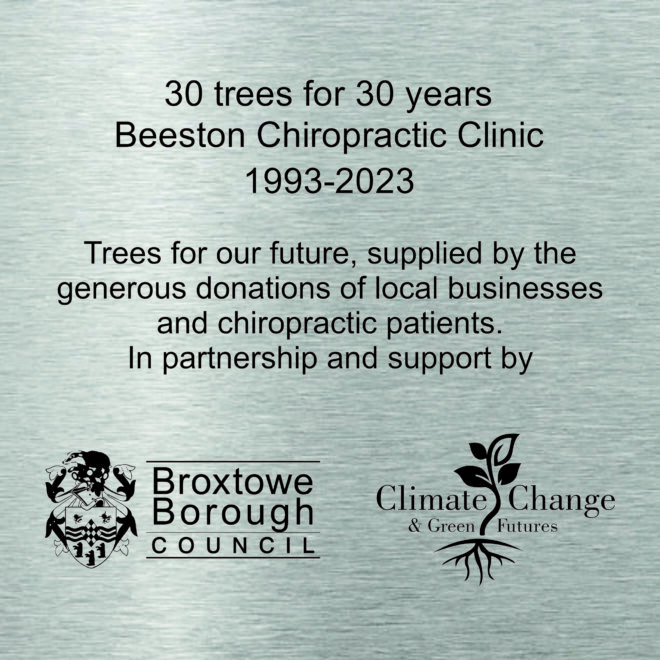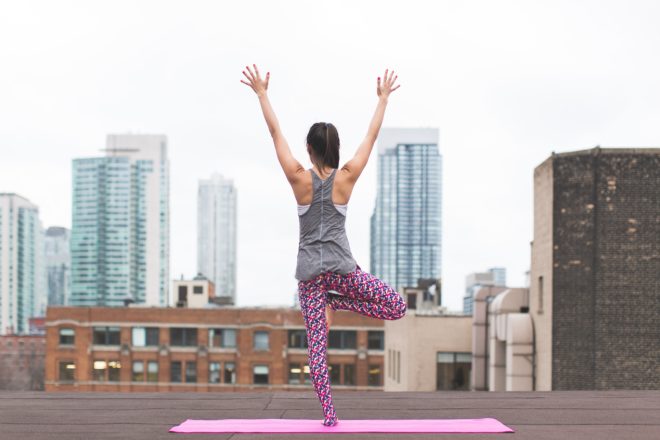
Clinic news
Come and join us for
TREE AND BULB PLANTING ON SATURDAY 4TH NOVEMBER 2023 FROM 2PM TO 4PM AT HETLEY PEARSON RECREATION GROUND - Queens Road West Beeston Nottingham NG9 1GT. REFRESHMENTS AVAILABLE. PLEASE BRING A SMALL TROWEL TO HELP WITH THE BULB PLANTING IF YOU CAN AND SOMETHING TO SIT ON IF YOU NEED A SEAT.
We are also delighted that The Mayor of Broxtowe, Cllr. Teresa Cullen will be joining us to witness the event.
The council will prepare and plant most of the trees in the preceding week so there will be only three or four trees to complete the planting and the spring bulbs to plant on the day. Come and help us if you can or just join this historic moment where we celebrate 30 years in Beeston.
Check out the plaque below that will be installed onsite.
We will have access to the clubhouse for toilets, hot drinks and some homemade cakes to keep you going. There is some onsite parking but please come by public transport if you can.
IMPORTANT NOTICE - ONLINE APPOINTMENT BOOKINGS NOW REQUIRE ADVANCED PAYMENT - SORRY FOR ANY INCONVENIENCE
It's been a very busy month with all the chiropractors having some time away from the clinic for holidays and conferences etc. but we are back up to full speed now for October.
Thank you to all the patients who participated in the patient satisfaction questionnaire. We had over 150 completed surveys and this has provided great data for us to complete the Patient's Participation Quality Mark for the Royal College of Chiropractors. Alex will be flat out over the next 10 days racing to complete the document in time for the 13th October deadline.
Congratulations to Andrew Stone who won the chiropractic bundle prize draw for completing his questionnaire - he will receive a pillow, an ergonomic cushion, some K Tape and an ice pack.
Alex had a successful conference in Barcelona where there were over 10 presentations on the latest research and management of the younger child at The Kids Summit - this is a charity-organised event and proceeds are used to develop chiropractic research in the treatment of children. The lecturers gave their time for free and the quality of their presentations were outstanding. Alex came away with some valuable information which she will be sharing to support her young patients. Erin has signed up for the online learning version to help her develop her paediatric practice.
This month we look at the different problems many patients have with arm pains which can be anything from a frozen shoulder to carpal tunnel syndrome - we often support these types of conditions - ask your chiropractor more about your problem.

Arm Pain
There are thirty bones, over forty muscles and fourteen major nerves making your arm more diligent, dexterous and adaptable than any tool mankind can emulate. So why is it that when it starts to hurt, we so often ignore the pain and hope that it will go away? Are we scared or is it that we just don’t have the time to do anything about it? But arm pain is a warning signal and should not be ignored. More often than not arm pain is caused by injury to the area of pain but it can also be an indication of more serious underlying problems.
Constant overuse or micro-trauma can go unnoticed on a daily basis. If you go to the gym, play racket sports, use a computer, play musical instruments or even use the text on a mobile phone enough then overuse injuries are a likely cause of the pain. Positions that strain muscles repetitively are likely to result in an insidious onset of wrist or forearm pain such as carpal tunnel syndrome or lateral epicondylitis (tennis elbow).
Arthritis is the body’s way of trying to stabilise unstable joints. Joints can become unstable for many reasons from trauma to overuse. If joints are allowed to remain unstable they start to fuse stopping you from carrying on with everyday activities and the wrist and hands are often the first place arthritis attacks.
When neck pain is caused by muscle strain you may have aches and stiffness that spread to the upper arm and forearm. Shooting pain that spreads down the arm into the hand and fingers can be a symptom of a pinched nerve in the neck. The most common cause of a pinched nerve in the neck is arthritis. Bony growths (osteophytes) press on the nerve that branch from the spinal canal. A pinched nerve in the neck can also be caused by injury, a herniated disc, or a tumour or infection of the spine. When a nerve has been pinched in the neck, numbness and weakness of the hands or arms as well as pain, may occur.
Heart problems can often cause referred pain in the left arm due to the shared neural pathways in the spinal cord. Information about the heart can be confused in the spinal column leading to apparent pain in the arm. Arm pain accompanied by chest pain or shortness of breath may signal a heart attack. Treat this as a medical emergency.
Hormonal changes such as those during pregnancy can cause wrist pain. Numbness and pain in your wrists and hands can also be an indication of thyroid and diabetic problems.

New Exercise Regime Preparation
Don’t launch yourself into a new exercise regime without taking the necessary precautions to prevent back and neck pain…
While more exercise can in fact improve bone mass density and prevent osteoporosis, throwing yourself into a full-on physical programme after a lull in activity could put your back and neck at risk. Try introducing your body to exercise in a safe way by following these easy tips:
Preparation
- Before you begin any exercise programme, check that there are no medical reasons why you cannot carry out the activity, particularly if you are not used to the type of exercise
- Make sure you wear the right clothing while carrying out your chosen activity. Wearing clothes that are too tight could constrict your movement and lead to injury; appropriate footwear is a must for any type of exercise
- Make sure you warm up before exercises; don’t go straight in and start with lighter movements like walking or jogging to lessen the chance of muscle strain
Equipment
Ensure that you are using equipment properly to prevent injuries.
Weights
- make sure legs are at least hips width apart
- lift with bent knees
- never keep knees straight, as this could lead to over-stretching and cause damage to your back
- work with weights closer to your body to help avoid injury
Machines
- make sure the seat is positioned correctly for your height
- avoid stooping or reaching when using equipment or you could over-stretch your back
Stretching
Stretches and exercises designed to strengthen your back will help prevent injuries later on. Try sequences of precise, slow stretches, which will help build up your strength.

Eating to beat stress
Chronic stress can have a negative effect on our physical health as well as our mental wellbeing. It can play a role in our susceptibility to illness and disease, but also in day-to-day functional problems such as pain and stiffness.
There are many steps we can take to improve our ability to cope with stress; nutrition is one of them. Find out what and how to eat to better manage stress…
Balancing your blood sugar
To cope well with stress, we need our food to provide us with balanced, sustained energy. Foods that quickly break down into glucose and are quickly absorbed – such as sugary foods and fast-releasing carbohydrates – may give us a burst of energy, but can cause our blood sugar to peak and then dip. This can actually increase our body’s stress response and stress hormone levels, as well as making us feel irritated and out of control.
Here are the three fundamental steps to balancing your blood sugar:
- Eat primarily whole foods: vegetables, animal foods (eggs, fish, unprocessed meat, unsweetened dairy foods), nuts and seeds, beans and lentils, and some fruit. Avoid sugary snacks, refined carbohydrates and other processed foods such as breakfast cereals
- Making sure every meal includes a good serving of protein, healthy fats, and complex carbohydrates. The primary protein foods are the animal foods mentioned above, and nuts and seeds, and beans and lentils. Healthy fats are found in nuts and seeds, oily fish, avocadoes, and coconut. Complex carbs are found in vegetables, whole fruit (i.e. not fruit juices), whole grains, beans and lentils
- Eat regularly. Skipping meals or leaving too long between meals can cause your blood sugar level to drop too low, which can also trigger a stress response
Getting enough food
As well as eating regularly, getting enough food is important when you’re dealing with stress. Going on a weight loss diet – whether it’s low-calorie, low-carb or low-fat – during a stressful time can be particularly bad for your stress levels. Instead, now is the time to focus on balancing your blood sugar as outlined above, by eating regular meals, getting enough protein, healthy fats and non-starchy vegetables and cutting the refined carbohydrates and junk foods. You should find it easier to manage your weight – or lose weight – by eating in this way anyway.
Healthy snacking
Although regular snacking is not the best thing for everyone, it can be helpful if you’re coping with stress, again by helping to keep your blood sugar on an even keel. Your snacks need to be based on whole foods, and contain some protein and complex carbohydrates.
Examples include:
- Two or three oatcakes with one of the following: a tablespoon of hummus, guacamole, cottage cheese, half an avocado, a hard-boiled egg or a teaspoon or two of nut butter (e.g. almond butter).
- A pot of natural yoghurt (without added sugar) with some berries and/or a tablespoon of pumpkin seeds mixed in.
- A wedge of left-over home-made frittata/omelette.
However, you shouldn’t need to be snacking more than once between meals; constantly ‘grazing’ can have a negative effect on your weight and your digestion!
Magnesium-rich foods
The mineral magnesium plays a vital role in our psychological health, including our mood and how well we cope with stress. It’s thought that both physical and emotional stress can increase the body’s need for magnesium; and that having a low magnesium to calcium ratio can actually increase the release of stress hormones such as adrenaline.
The best food sources of magnesium are green leafy vegetables such as kale, chard and spinach; seeds and nuts; and whole grains – especially buckwheat and rye.
B vitamin-rich foods
Like magnesium, B vitamins also play a vital role in our energy as well as our psychological function.
The various B vitamins are found in different foods, but the best all-round sources include eggs, oily fish, organ meats (especially liver), seeds and nuts, and beans and pulses. Luckily these are also foods that are great for our blood sugar balance!
Avoid overdoing stimulants
Many of us turn to stimulants such as tea and coffee when we’re feeling stressed. But stimulants of any kind also trigger the body’s stress response. Try to keep your coffee consumption in particular to a minimum. Tea can have a gentler stimulating effect so can be better tolerated, but keeping it to one cup a day can still be advisable. Try to introduce calming herbal teas such as chamomile and spearmint – especially later in the day.
Note that alcohol can also act as a stimulant as well as a relaxant. It also disrupts your blood sugar balance. Keep alcohol as a rare treat and stick to one drink only.

Low impact exercise
A workout doesn’t have to include jumping or jogging to be effective. In fact, high impact exercises can be jarring on the body or joints, placing you at greater risk of injuries. Low impact exercises can improve your fitness and health, without causing harm to your joints.
What is low impact exercise?
It is important to remember that low impact doesn’t equate to less effort, or low intensity. Exercises that are gentle on your body and joints, or are performed in a fluid motion, are considered low impact. Though this can be less strenuous, low impact exercises can be adjusted to suit all fitness levels.
When is low impact exercise a better option?
Opting for low impact exercise can be better if you have suffered an injury or faced illness. Low impact exercise is a great way to get moving and maintain your fitness without placing stress on your joints. It can also be a good starting-point if you are new to exercise or pregnant, for example.
What are some examples of low impact exercise?
There are plenty of options for low impact exercise, but some of the most popular include:
- Walking
- Dancing
- Cycling
- Swimming
- Yoga
- Pilates
What are the benefits to low impact exercise?
Alongside injury prevention, many forms of low impact exercises focus on developing flexibility and improving strength or balance. These are important for maintaining a healthy and active body. Low impact exercise can also be used as an active recovery from high intensity activities.
We treat all conditions that affect any muscle or joint in your body, from your head to your little toe! One of the most common complaints that we treat is back pain and Chiropractic is recommended by the government authority, the National Institute for Clinical Excellence (NICE) for acute and chronic back pain. Some of the other conditions that we treat are neck and headache, shoulder pain, leg and hip pain, knee and foot pain, sciatica and arthritis. Our registered Chiropractors all have at least five years of training. Treatment costs can be covered through most health insurers. If you are in any doubt, we are always very happy to talk with you on the phone to see if your condition will respond well to Chiropractic treatment. Call the clinic now to arrange an appointment time that works for you. 0115 9225085 If you would like to opt-out of receiving these newsletters please follow the unsubscribe link below, email alex@beestonchiropractic.co.uk or let us know at your next appointment.





